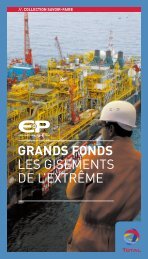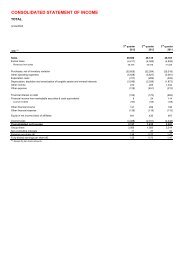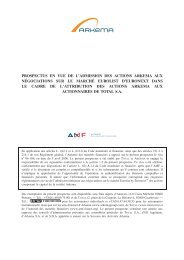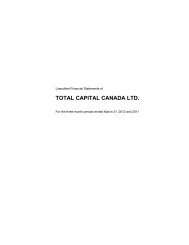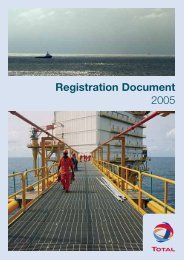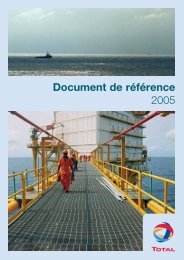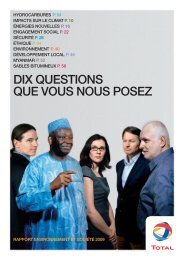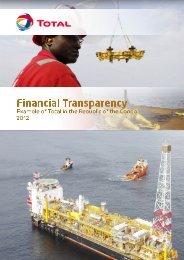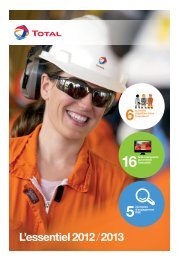Registration document 2007 - Total.com
Registration document 2007 - Total.com
Registration document 2007 - Total.com
You also want an ePaper? Increase the reach of your titles
YUMPU automatically turns print PDFs into web optimized ePapers that Google loves.
9<br />
In equity affiliates, the book value of goodwill is included in the<br />
book value of the investment. Other intangible assets (except<br />
goodwill) have a finite useful life and are amortized on a straightline<br />
basis over 10 to 40 years depending on the useful life of the<br />
assets.<br />
Research and development<br />
Research costs are charged to expense as incurred.<br />
Development expenses are capitalized when the following can be<br />
demonstrated:<br />
• the technical feasibility of the project and the availability of the<br />
appropriate resources for the <strong>com</strong>pletion of the intangible<br />
asset;<br />
• the ability of the asset to generate probable future economic<br />
benefits;<br />
• the ability to measure reliably the expenditures attributable to<br />
the asset.<br />
Advertising costs are charged to expense as incurred.<br />
J. Other property, plant and equipment<br />
Other property, plant and equipment are carried at cost, after<br />
deducting any accumulated depreciation and accumulated<br />
impairment losses. This includes interest expenses incurred until<br />
assets are placed in service. Investment subsidies are deducted<br />
from the cost of the related expenditures.<br />
Routine maintenance and repairs are charged to expense as<br />
incurred. The costs of major turnarounds of refineries and large<br />
petrochemical units are capitalized as incurred and depreciated<br />
over the period of time between two major turnarounds.<br />
Other property, plant and equipment are depreciated using the<br />
straight-line method over their useful life, as follows:<br />
• Furniture, office equipment, machinery and tools 3-12 years<br />
• Transportation equipments 5-20 years<br />
• Storage tanks and related equipment 10-15 years<br />
• Specialized <strong>com</strong>plex installations and pipelines 10-30 years<br />
• Buildings 10-50 years<br />
K. Leases<br />
A finance lease transfers substantially all the risks and rewards<br />
incidental to ownership from the lessor to the lessee. These<br />
contracts are capitalized as assets at fair value or if lower at the<br />
present value of the minimum lease payments according to the<br />
contract. A corresponding financial debt is recognized as<br />
financial liabilities. These assets are depreciated over the useful<br />
life used by the Group.<br />
Leases that are not financial leases as defined above are<br />
recorded as operating leases.<br />
176<br />
Appendix 1 – Consolidated financial statements<br />
Notes to the consolidated financial statement<br />
TOTAL – <strong>Registration</strong> Document 2006<br />
Certain arrangements do not take the legal form of a lease but<br />
convey the right to use an asset or a group of assets in return for<br />
fixed payments. Such arrangements are accounted for as leases<br />
and are analyzed to determine whether they should be classified<br />
as operating leases or as financial leases.<br />
L. Impairment of long-lived assets<br />
The recoverable amounts of intangible assets and property, plant<br />
and equipment are tested for possible impairment as soon as<br />
there is any indication that the assets may be impaired. This test<br />
is performed at least annually for goodwill.<br />
The recoverable value is the higher of the sale price (net of sale<br />
expenses) and its useful value.<br />
For this purpose, assets are grouped into cash-generating units<br />
(or CGUs). A cash-generating unit is a group of assets that<br />
generates cash inflows that are largely independent of the cash<br />
inflows from other groups of assets.<br />
The recoverable amount of a CGU is determined by reference to<br />
the discounted future cash flows expected from it, based upon<br />
management’s expectation of future economic and operating<br />
conditions. If the recoverable amount is less than the carrying<br />
amount, an impairment loss on property, plant and equipment<br />
and leaseholds rights, or on other intangible assets is recognized<br />
either in “Depreciation, depletion and amortization of tangible<br />
assets and leaseholds rights” or in “Other expense”, respectively.<br />
In priority, this impairment loss is recorded against goodwill.<br />
Impairment losses recognized in prior periods could be reversed<br />
up to the net book value that the asset would have had, had the<br />
impairment loss not been recognized. Impairment losses<br />
recognized for goodwill are not reversed.<br />
M. Financial assets and liabilities<br />
Financial assets and liabilities are financial loans and receivables,<br />
investments in non-consolidated <strong>com</strong>panies, publicly-traded<br />
equity securities, financial derivatives, current and non-current<br />
financial liabilities.<br />
The accounting treatment of these financial assets and liabilities<br />
is as follows.<br />
(i) Financial loans and receivables<br />
Financial loans and receivables are recognized at amortized cost.<br />
They are tested for impairment, the net book value being<br />
<strong>com</strong>pared to estimates of the discounted future recoverable cash<br />
flows. These tests are conducted as soon as there is any<br />
evidence that their fair value is less than their net book value, and<br />
at least annually. The potential loss is recorded in the statement<br />
of in<strong>com</strong>e.<br />
(ii) Investments in non-consolidated <strong>com</strong>panies and<br />
publicly-traded equity securities<br />
These assets are classified as available for sale and therefore<br />
measured at their fair value. For listed securities, this fair value is




